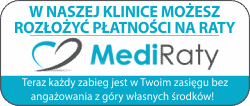These are various techniques that use trauma as a natural skin response to the stimulation of epidermal and dermal cells.
Skin revitalisation
Stages of skin “healing” after revitalisation treatments::
- inflammation – a number of chemical reactions strictly controlled by the immune system. This involves growth in the number of growth factors for epidermal, vascular cells as well as substances that stimulate fibroblasts (cells producing collagen and elastin) – it takes several dozen hours.
- new tissue formation – this process takes even up to several months and involves intensified production of proteins and mucopolysaccharide substances,
- tissue modelling – this process is the longest, lasts up to a dozen or so months. In this phase type III collagen (“young”) transforms into type I collagen (strong, dense) – great as support for skin.
Zabiegi wykorzystywane w rewitalizacji:
![]() microdermabrasion,
microdermabrasion,
![]() chemical peelings,
chemical peelings,
![]() cavitation peeling,
cavitation peeling,
![]() mesotherapy,
mesotherapy,
![]() regeneris,
regeneris,
![]() ultrasounds,
ultrasounds,
![]() ionophoresis,
ionophoresis,
Wskazania do rewitalizacji skóry:
![]() loss of firmness, skin limpness
loss of firmness, skin limpness
![]() symptoms of tiredness (overworking, stress)
symptoms of tiredness (overworking, stress)
![]() hypoxia, skin malnutrition
hypoxia, skin malnutrition
(tobacco smokers, sagging skin)
![]() skin conditioning after delivery
skin conditioning after delivery
![]() hydration, restoring brightness after summer season
hydration, restoring brightness after summer season
(sun tanning)
![]() mesh of wrinkles
mesh of wrinkles
![]() strengthening effects of lifting operations
strengthening effects of lifting operations
Areas best qualified for revitalisation::
![]() face,
face,
![]() neck,
neck,
![]() neckline,
neckline,
![]() palms,
palms,
The selection of treatments is based on individual needs that account for: area of body, type of complexion and patient’s expectations. It involves treatments that accurately address a given problem or generally improve skin condition and looks.
Efekty:
![]() improved skin condition,
improved skin condition,
![]() toning,
toning,
![]() lighter skin colour,
lighter skin colour,
![]() skin tension and its improved firmness,
skin tension and its improved firmness,
![]() removal of minor wrinkles, evening deeper ones,
removal of minor wrinkles, evening deeper ones,
Skin revitalisation programmes (combined techniques)::
- microdermabrasion + mesotherapy/mesolift Results:
- removal of the epidermal horny layer
- stimulation of blood and lymph circulation
- providing oxygen and nutrients
- stimulation of collagen and elastin synthesis
Indications:
- seborrheic skin with enlarged pores
- scars and post-inflammation blemishes
- neckline and hand skin
Frequency: 1-4 treatments every 2-4 weeks
- cavitation peeling + mesotherapy/mesolift :
- ultrasound epidermal cleansing
- skin smoothing
- brightening of blemishes
Indications:
- overreactive skin
- telangiectasia
- blemishes
Frequency:
blemishes: 4 times every 2 weeks skin cleansing and hydration: every 2-3 months - chemical peelings + mesotherapy/mesolift
- smoothing wrinkles
- improved hydration
- enhanced elasticity
Indications:
- face, neck, neckline and hand skin
Frequency: intensive treatment: 4 treatments every 2 weeks. Maintenance treatment: every 2-3 months
- mesolift + ultrasounds
- improved skin hydration (with the use of ultrasounds – after mesolift – 2-5% of the preparation can be additionally entered into dermis with hyaluronic acid)
- improved skin brightness (colour, composition)
- enhanced elasticity
Indications:
- regeneration of damaged, sagging skin
Frequency: intensive treatment: 4 treatments every 2 weeks. Maintenance treatment: every 2-3 months
- microdermabrasion + chemical peeling
Results:
- exfoliation of epidermal corny layer
- smoothing wrinkles
- brighter complexion
- firmer skin
Indications:
- mature, seborrheic skin
- skin with photo-ageing symptoms (stains)
Frequency: 1-4 treatments every 3-4 weeks
- regeneris
Results ensured by the application of Regeneris:
- skin revitalisation, smoothing and evening of skin colour, improved elasticity, firmness and density
- remodelling of collagen fibres
- improved skin vascularisation
- smoothing wrinkles and folds – volumetric therapy bio-stimulating skin cells
- accelerated healing processes after aesthetic medicine treatments
Most popular preparations:
- Peeling: Glycopeel
- GlyKoPeel 70® with concentration of 70% and pH 1.75,
- GlyKoPeel 50® with concentration of 50% and pH 1.85,
- GlyKoPeel 20® with concentration of 20% and pH 2, dedicated to sensitive skin
It includes: strong exfoliating agent (glycolic acid), depigmentation agents (kojic acid and Arctostaphylos uva-ursi extract), natural compounds soothing skin irritation (Murus alba extract) and vitamins: A, C and E that optimise the effect of the peeling. GlyKoPeel® can be used throughout entire year, even in summer at the time of exposition to the sun and during frosts.
Preparations on the basis of glycolic acid:
2. Retises CT
Retises CT is a two-phase peeling; first, an ampoule with vitamin C is applied on the skin, neck, neckline, followed by a mask with retinol and lactic acid. Indication for mature, matt skin with a large number of wrinkles and pigment spots.
